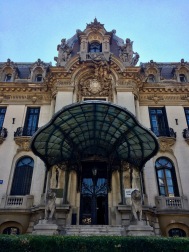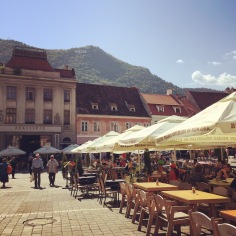August 21, 2017 – August 31, 2017
I had always wanted to visit Romania, because… vampires. With no intention of knocking Twilight fans (you do you), I’ve had a longstanding fascination with all things Dracula. This fixation dates back to 1994, at two-years-old, predating and not including Robert Pattin- er, Edward Cullen. My favorite books included an illustrated guide to vampires, The Thirteen Nights of Halloween, Winnie the Witch, progressing gradually to chapter books including the literary classics Scary Stories to Tell in the Dark, Bunnicula, and, predictably, the Harry Potter series. I’ve attempted to mix it up, striving not to be too narrow over the years, but dark folklore and haunted happenings remain themes in my repertoire of books-read. Two of my adult favorites are Salem’s Lot and, and naturally, Dracula. I supplement my commitment to the horror genre with Aaron Mahnke’s biweekly podcast, Lore, which I recommend to anyone interested in dark historical tales.

George Enescu Museum
Until I began planning my trip, my knowledge of Romania was limited to Transylvania-inspired folklore made internationally famous by Bram Stoker. I had seen photographs of leafy vines adorning Brancovian and Art Nouveau-style blocks throughout Bucharest, veins of life in a city strewn with abandoned buildings and imbued with tremendous poverty. I had seen photographs of castles in the countryside, some in ruin, some carefully preserved, and whether or not they had anything to do with Vlad Dracul (Vlad the Impaler), I imagined they did. I knew little of the political unrest that has divided Romania in a significant way, of the social, religious, and political oppression accounting for the drastic disparity between the affluent and impoverished, and of the country beyond its largest city and its most popular region, Transylvania.
My observations as a visitor, an outsider without a connection to Romania beyond an obsession with an Irishman’s fictional monster, were consistent with a description of the country by writer for Lonely Planet, Mark Baker. Baker writes:
When I travel, I’m attracted to contrasts. In Romania, that means scenes of overloaded hay- and horse-carts sharing highway space with speeding Audis, or in cities, rows of regal ruins of former palaces standing side-by-side with gleaming new office buildings. There’s never a dull moment. Bucharest has an unearned poor reputation, but through the cracks in the old facades, I see green shoots of creativity. It’s a city of hidden gardens and quirky cafes. Further afield, the rural and mountain areas are quiet, unexplored and still highly authentic. There’s a stillness and freshness in the air here that allows the mind freedom to roam.

Brașov
As I explored the country, tackling the wild highways ribboning through the mountains and unexpectedly falling for the smaller cities more quickly and intensely than even Bucharest, I found myself thinking, “I could live here.” It was easy to fall for the shoots of creativity, the hidden gardens and quirky cafes (the quirky cafes in hidden gardens, e.g. Gradina EDEN). I was spellbound by the bustling bookstores, the sartorial ingenuity, the ruins of Poienari Fortress and the amusement park deep underground, Salina Turda. I stayed the night in Brașov between Poienari and Cluj-Napoca, and realized instantly upon arrival that I should have designated more time to the city. Brașov was a dream, my dream, a city composed of strands of rainbow buildings, innovative restaurants, and funky young families framed by a fortress of majestic mountains. Cluj-Napoca, less intimate but no less charming, offer a seemingly endless assortment of courtyard cafes, bars, restaurants, and notably the opportunity to visit the first kinetic steampunk bar, Enigma. I wandered an enchanting botanical garden, visited neighborhood-like graveyards in which the tombstones were unique to the individuals lain to rest and not uniform, unfamiliar to an American tourist, and was able to experience quiet in a way I hadn’t in a long while on long, bucolic drives.

Cărturești Carusel
As a tourist, I had a remarkable experience in Romania. I found the people I encountered to be polite and hospitable, found it refreshing to visit a country in which I couldn’t assume people would understand my English (an experience embarrassingly unfamiliar for me, highlighting my privilege), and enjoyed the advantages of visiting a country in a weaker financial spot than my country of origin in terms of food and lodgings. There are endless Airbnb and hotel options that are shockingly affordable for American tourists, and the price-per-person of fine dining in Romania is comparable to that of a burger and fries in Boston. That being said, consistent with Baker’s perception of Romania’s contrasts, I picked up on some pervasive struggles and discrepancies possible to ignore as a visitor but likely more difficult to overlook as a citizen. A friendly host of one Airbnb gave us some insight into her critique of the Romanian education system, of the cost of living, and of missed opportunities she recognizes for Romanian leadership to improve quality of living for citizens. I suggest that any visitor to the country spend time getting to know the political context and past tensions between groups, Romanians, Hungarians, and Roma, and current difficulties prior to immersion.
Romania is a special place, and one that is experiencing rebirth in many realms following oppression and revolution. I was thrilled to finally to walk in the footsteps of my number two crush (second to my wonderful partner and travel companion), Vlad the Impaler, and to live out my dream of visiting Transylvania. I recommend the trip to Romania to anyone with a spirit for adventure and an appreciation for old-city charm and mountain-lined horizons. I would return in a heartbeat, and fully intend to do so.

Poienari Castle with Dracula (vampires not visible in photos)

